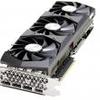In this review, we benchmark the GeForce RTX 3080 from ZOTAC, a very nice customized yet reference clocked product. It attempts to offer close to reference performance, good acoustics as well as a friendly design. All priced rationally as well, we hope.
Read the full review here.

